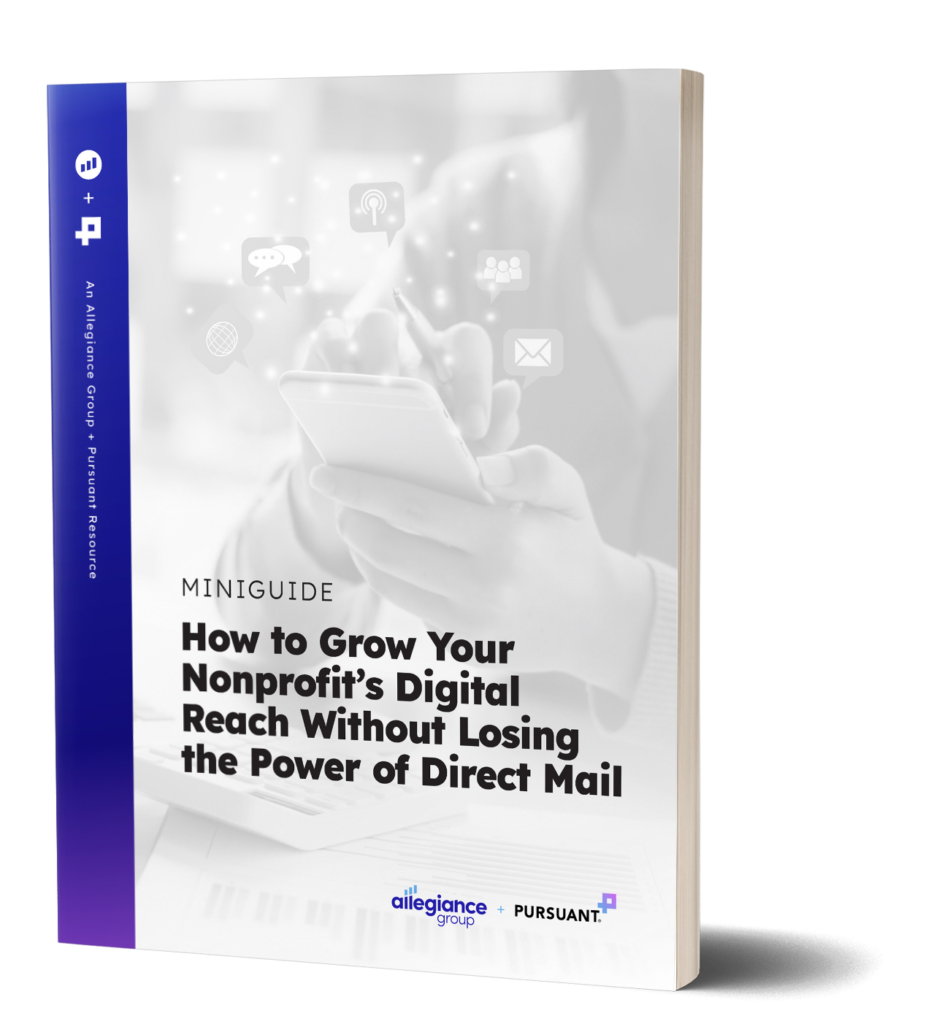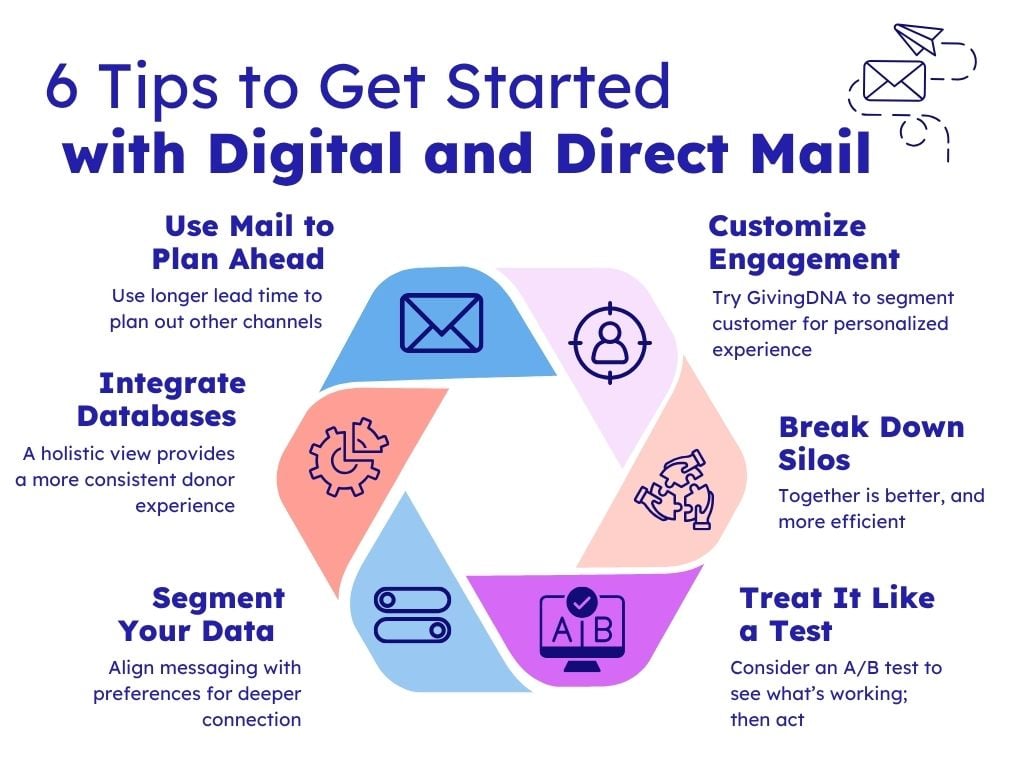Digital and Direct Mail Growth? Yes, You Can Have It All

In our digital-first world, it’s time to rethink direct mail. Not whether it’s still a viable fundraising channel — it definitely is — but how it can help you grow your online audience and create the meaningful experiences they crave.
Fundraisers face a wealth of challenges and more competition for donor dollars than ever. So many nonprofits focus only on digital or direct mail, but you don’t have to choose — nor should you. New digital trends make it easy to enhance your direct mail storytelling.
This is a both-and approach, where the right balance is key. A healthy direct mail program integrated with digital channels delivers a consistent omni-channel journey that inspires engagement and giving.
Direct Mail and Digital Fundraising Today
Over the last five to 10 years, there’s been a shift in how nonprofits approach mass communication with donors. This is partly due to changes in donor behavior. We’re seeing more transactional-level donors, who primarily give for a special event or reward, rather than because of a connection to the organization’s mission.
As printing and postage costs increase, mail files are growing shorter, and retention and response rates are dropping. At the same time, the overall donor pool is shrinking as competition from other nonprofits and for-profit businesses continues to rise.
Fundraisers may have more ways than ever to reach donors, but deep relationships are missing. This is an opportunity for nonprofits to be more intentional in their outreach.
On their own, fundraising appeals keep donors at arm’s length. Repeated social media posts only add to the online noise. Emails get lost in inboxes. Random text messages are easy to ignore. A plain, white #10 envelope can be mistaken for a bill or junk mail.
But when these elements come together in a cohesive campaign — carrying a compelling story throughout — nonprofits create an immersive journey that engages donors and prospects across channels. And this may surprise you, but the journey begins with an eye-catching mail piece.
Direct Mail: Where Marketing & Fundraising Meet
This isn’t the direct mail of 20 years ago or even 10 years ago. A letter with a return envelope and a premium like address labels aimed for a quick gift, and you could usually count on a response from each mailing. This put mailers firmly in the realm of your fundraising or development department.
Today, though, nonprofits must think holistically. It takes three to five touchpoints to inspire action, so a letter or postcard is just one piece of the puzzle.
A direct mail piece can reach a significant number of prospective and existing donors, creating just as many brand impressions that your organization wouldn’t otherwise have. This makes it an extremely valuable marketing tool, as it could be the first exposure someone has to your brand.
Use your letter or postcard to kick off a cohesive experience, both offline and online. Let it start with the envelope by adding an image or QR code. You’ll gain instant brand awareness and give recipients a way to donate immediately.
Then, reinforce the message with complementary emails, digital ads, and social media posts. Modern digital tools make this easier than ever.

Go deeper with our guide: “How to Grow Your Nonprofit’s Digital Reach Without Losing the Power of Direct Mail”
Digital Trends Continue the Story
Digital channels are pretty much baked into most fundraising strategies, although the approach is often scattershot. But independent posts, emails, and texts only contribute to digital fatigue. People have become numb to the online noise.
Storytelling is the difference-maker. Your organization’s story begins with a letter or postcard and continues through your digital efforts to acquire donors and keep them engaged.
Social media trends include a number of engagement tools, many of which are free. For instance, Facebook and Instagram stories now allow anyone to include a link. You can also create informal surveys or polls to encourage donor participation. Even though stories go away after 24 hours, you can add them to your profile’s highlights section, where they’ll stay longer.
If you haven’t embraced video yet, now is the time. Don’t worry, your constituents don’t expect a polished, Hollywood-worthy film. They prefer authenticity, which you can accomplish in a 1- or 1.5-minute video recorded on your phone or computer.
Digital channels like social media and ads are often considered marketing tools because they build awareness. But with a cohesive story, they become fundraising powerhouses that give your supporters multiple opportunities to engage and donate.
Mail + Digital: Walk, Jog, Run
Depending on where you are with your direct mail and digital efforts, a walk-jog-run approach can help you take it to the next level. Here are some tips to get started.

Use Mail to Plan Ahead
Direct mail has a longer lead time than digital channels, allowing you to plan a complete campaign well before it launches. Determine the story you’ll tell in the letter, then work out how to distill it to other channels.
Integrate Databases
It’s okay to have separate databases for your online and offline efforts as long as they can talk to each other. This will give you a holistic view of your campaign results, allowing you to see the complete donor journey and the top-performing channels. It will also help you deliver a more consistent experience.
Segment Your Data
Group donors together so you can speak to them more meaningfully. Your messages should make sense based on their history with your organization. For instance, group people who responded to a campaign in the previous three years together so you can remind them of their past support.
Customize Engagement
A tool like GivingDNA lets you examine donors’ demographic and psychographic information to provide a custom experience. Considering their age, income level, political leanings, and other characteristics enables you to create messaging that better aligns with their preferences. You can also use this information to target lookalike audiences of prospective donors.
Get weekly fundraising tips straight to your inbox
Break Down Silos
It’s time to move beyond thinking of fundraising and marketing as two separate departments. Each marketing effort is a touchpoint that could lead to a donation, and fundraisers’ donor data can inform a more personalized brand experience. Set joint goals and even share budgets to develop fundraising appeals that raise more money and establish a positive brand impression.
Treat It Like a Test
If you’re not quite ready to fully invest in a direct mail approach backed by digital channels, consider it an A/B test. Add one digital aspect to your mailing, such as a QR code that leads to a branded giving site. Then, sit back and see what happens. If the needle moves, test another small step.
Digital and Direct Mail Working as One
Expanding your digital channels while optimizing your direct mail efforts doesn’t take a significant investment. It’s all about consistent, meaningful messaging.
Getting started is easy: just start. Plan a test, try an integration, or have fun with a free social media tool. Use whatever budget you have to expand your footprint on one channel, then move on to the next. Keep your focus on the story you want to tell, then get creative with how you can tell it. The more donors see of your mission in action, the more inspired they’ll be.
If you want to bring harmony to your direct mail and digital fundraising, contact Allegiance Group + Pursuant. We can help you develop an engaging story that moves donors across channels and guides them toward a gift.
This blog is based on an episode of the Go Beyond Fundraising podcast. Listen to the complete conversation now.